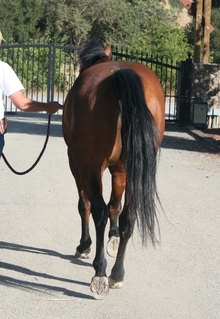Navicular syndrome is a common cause of lameness in horses. Horses diagnosed with this syndrome are often treated with coffin joint injection of the corticosteroid triamcinolone acetonide (TA) in combination with sodium hyaluronate (HA).

Lameness exam of walking horse
Injection of the coffin joint with Triamcinolone acetonide appears to be an effective way to deliver corticosteroids to the navicular bursa in horses clinically affected by navicular syndrome.
Although injection of the coffin joint relieves lameness in many of these cases, it has been suggested that direct injection of corticosteroid into the navicular bursa is a more specific treatment which results in a better outcome.
Injection of the navicular bursa is a more difficult procedure than injection of the coffin joint though, often requiring radiographic guidance to place the needle in the bursa. Previous studies have demonstrated that there is no direct communication between the coffin joint and the bursa so it is unknown whether TA will diffuse from the coffin joint to the bursa.
Additionally, HA is a thick solution and could potentially block diffusion. However, we suspected that TA would diffuse from the coffin joint to the navicular bursa in normal horses and that this diffusion would not be hindered by the addition of HA. The overall goal of our study was to determine whether injection of TA into the coffin joint was a viable treatment option for horses with navicular syndrome.
In the first part, 11 horses with no evidence of foot pain or navicular syndrome were enrolled in the study. One forelimb coffin joint was injected with TA and the opposite forelimb coffin joint injected with TA + HA. One hindlimb served as a control limb (to determine if diffusion of the corticosteroid was through the bloodstream). Six hours after injection of the coffin joints, navicular bursal fluid samples were taken from each forelimb and one hindlimb control. The fluid was analyzed for the presence of TA.
Triamcinolone acetonide was found in all navicular bursas sampled, including the hindlimb control bursas. However, the levels of corticosteroid in the forelimb navicular bursas were significantly higher than the hindlimb controls.
These results indicate that while some of the drug was absorbed into the bloodstream and able to move into remote (non-injected) joints, the majority of the corticosteroid diffusion was local. There was no difference in TA levels between forelimbs showing that addition of HA did not alter diffusion of the corticosteroid.
In the second part, 11 additional horses with clinical and radiographic signs of navicular syndrome were identified. The possibility existed that changes in the foot (thickened joint lining, scar tissue, etc) would prevent movement of corticosteroid in the diseased horses.
Both front coffin joints were injected with TA and the same fluid samples were taken as in the first study. Foot radiographs were also scored for severity of navicular changes.
Triamcinolone acetonide was found to move from the coffin joint into the navicular bursa in all of the horses with navicular syndrome. The severity of radiographic changes was not significantly associated with amount of TA found in the front limb bursal fluid samples.
Unfortunately, no studies have been performed that show what level of corticosteroid is necessary to control pain in the equine joint or bursa. Levels of TA were high enough to suggest this type of treatment is likely to work.
This study lead by Mary Boyce, DVM ACVS Surgeon, at the University of Minnesota has demonstrated that injection of the coffin joint with TA appears to be an effective way to deliver corticosteroids to the navicular bursa in horses clinically affected by navicular syndrome.
